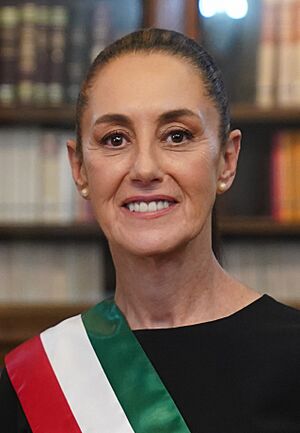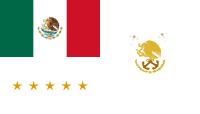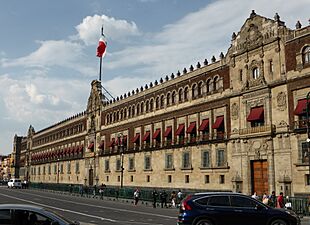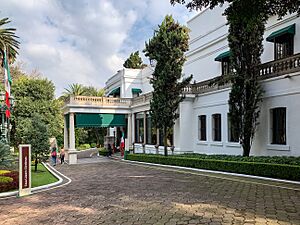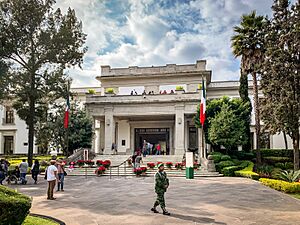President of Mexico facts for kids
Quick facts for kids President of theUnited Mexican States |
|
|---|---|

Presidential Standard
|
|

Logo of the President's Office
|
|
| Executive branch of the Mexican Government | |
| Style | Madam President (title) (informal) The Honorable (formal) Her Excellency (diplomatic) |
| Residence | National Palace |
| Seat | Mexico City |
| Appointer | Popular vote |
| Term length | Six years
non renewable
|
| Constituting instrument | Constitution of Mexico (1917) |
| Precursor | Emperor of Mexico |
| Formation | 10 October 1824 |
| First holder | Guadalupe Victoria |
| Succession | Line of succession |
| Deputy | Secretary of Interior |
| Salary | MX$208,570.92 (monthly) |
The President of Mexico is the top leader of the country. This person is both the head of state and the head of government for Mexico. They lead the executive branch of the government. They are also the commander in chief of the Mexican Armed Forces.
The idea of a president for Mexico started with the first federal Constitution in 1824. Today, Claudia Sheinbaum holds this important job. She started her term on October 1, 2024. The President's powers come from the Constitution of 1917, which was created after the Mexican Revolution.
One special rule from the Mexican Revolution is that a president can only serve one six-year term. This term is called a sexenio. No one who has been president, even for a short time, can ever run for or serve again. This rule is very important in Mexican politics.
Contents
Becoming President: What It Takes
The Mexican Constitution explains who can become president and what powers they have. It says the president holds the "Supreme Executive Power of the Union."
To be able to serve as president, a person must meet these requirements:
- Be born in Mexico. At least one parent must also be a natural-born citizen of Mexico.
- Have lived in Mexico for at least twenty years.
- Be at least thirty-five years old when the election happens.
- Have lived in Mexico for the whole year before the election. Short trips (30 days or less) don't count as leaving residency.
- Not be a leader or minister of any church or religious group.
- Not be actively serving in the military during the six months before the election.
- Not be a secretary of state, attorney general, state governor, or head of Mexico City's government. If they hold one of these jobs, they must leave it at least six months before the election.
- Never have been president before, even temporarily.
The rule about not being re-elected comes from a time when Porfirio Díaz was president for many years. He won seven elections in a row, which led to the Mexican Revolution. This rule is still very strong in Mexico. Even though other officials like city mayors or members of Congress can now be re-elected for a second term, the president cannot.
Most presidents in the past were either military officers or lawyers. For example, many presidents from 1958 to 1988 were lawyers. More recently, presidents have come from different fields. Vicente Fox studied business, Andrés Manuel López Obrador studied political science, and the current president, Claudia Sheinbaum, studied physics.
How Presidents Are Chosen
The presidential term in Mexico is six years. This length was set in 1928 and has not changed since. People vote directly for the president. The person who gets the most votes wins the election. There is no second round of voting.
For example, Andrés Manuel López Obrador won with 53% of the votes in 2018. Enrique Peña Nieto won with 38% in 2012. Felipe Calderón won in 2006 with a very close 36.38% of the votes.
After the Mexican Revolution, the government was not very stable. Then, in 1929, many revolutionary leaders formed one political party. This party eventually became known as the Institutional Revolutionary Party (PRI). The PRI ruled Mexico for a very long time, almost like a single-party government.
For many years, the outgoing president would secretly choose the PRI's next candidate. This was known as el dedazo, meaning "appointed by the finger." Since the PRI almost always won, their candidate was almost guaranteed to become president.
However, things started to change. In 1988, there were questions about the election results. Then, in 2000, Vicente Fox from an opposition party won the presidency. This was a huge moment for Mexico, showing that different parties could win.
What is a President-elect?
After an election, political parties can challenge the results. The Federal Electoral Tribunal listens to these challenges. After they decide, they either say the election is invalid or confirm the results. Once the Tribunal says the election is valid, they give a special "Certificate of Plurality" to the winner. That person then becomes the President-elect. This final decision usually happens in September, two months after the election.
What the President Does
The Mexican Constitution gives the president many important powers. For a long time, especially when the PRI was the main party, the president had a lot of control over the country. They could even choose who would be the next president. This system was sometimes called an "imperial presidency" because the president had so much power.
However, with more democratic elections in recent years, the president's powers have become more balanced. Now, the president's rights and powers are clearly listed in Article 89 of the Constitution. Here are some of the main things the president can do:
- Make sure laws passed by Congress are followed.
- Choose and remove Secretaries of State, ambassadors, and other important government workers.
- Appoint military officers like colonels and generals, with approval from the Senate.
- Keep the country safe and lead the Mexican Armed Forces (Army, Navy, and Air Force).
- Use the National Guard for internal security and defense.
- Declare war if Congress agrees.
- Lead Mexico's foreign policy, which includes making international treaties. They must follow principles like respecting other countries and promoting human rights.
- Ask Congress to meet for special sessions if needed.
- Help the courts do their job quickly.
- Grant pardons to people convicted of federal crimes.
- Give special, limited-time rights to inventors or discoverers in industries.
- Work with political parties in Congress to form a coalition government.
- Suggest three candidates for Supreme Court judges to the Senate.
The president also issues "decrees," which are like special rules that have the power of laws but are very specific. For example, the president can suggest a national budget, but Congress is the one that officially approves it.
Since 1997, Mexico's Congress has often had members from different parties, not just the president's party. This means the president often has to work with other parties to pass major changes. This has made the president's power more limited than it used to be, which is a sign of a stronger democracy.
Taking the Oath
When a new president starts their job, they raise their right arm and say an oath. This oath is a promise to follow and protect the Mexican Constitution and its laws. They promise to serve the country loyally and patriotically, always working for the good of the Union. If they don't, they say the Nation can hold them accountable.
The president officially starts their term at midnight on October 1st, even if the oath ceremony happens later in the day.
Symbols of Office
The president wears a special Presidential Sash that has the colors of the Mexican flag: green, white, and red. It also has the National Seal in gold. The sash is worn from the right shoulder to the left hip. It is a symbol of the president's power and only the current president can wear it.
During the swearing-in ceremony, the outgoing president gives the sash to the new president. The president also wears the sash for important events like their annual report to Congress, the celebration of the Grito de Dolores (Mexico's cry for independence), and when meeting foreign ambassadors.
Each president also gets a Presidential Flag. This flag has the words "Estados Unidos Mexicanos" (United Mexican States) and the national coat of arms printed in gold.
Where the President Lives and Works
The main official home and workplace of the president is the National Palace in Mexico City. This building has been a center of power since the time of the Aztec Empire. From 1824 to 1884, it was both the president's home and the main government office.
While it stopped being a residence for many years, President Andrés Manuel López Obrador moved into an apartment there in 2019, making it the official residence again.
From 1884 to 1934, Chapultepec Castle was the presidential residence. Before that, it was even an imperial residence.
In 1935, President Lázaro Cárdenas moved the official residence to a place called Rancho La Hormiga, which he renamed Los Pinos. Most presidents after him lived there until 2018. The Los Pinos complex grew to include offices, guest rooms, and other facilities.
- Presidential residence
-
National Palace, the official residence
- Former presidential residences
What Happens if a President Can't Serve?
The Mexican Constitution has rules for what happens if a president cannot continue their term. This is called "absolute absence."
- If the president is suddenly unable to serve, the Secretary of the Interior takes over temporarily. They are called the "Provisional President."
- Congress then has to choose an "Interim President" or "Substitute President" within 60 days.
- If the absence happens in the first two years of the six-year term, Congress chooses an Interim President. Then, new elections are called within 14 to 18 months. The winner finishes the rest of the original six-year term.
- If the absence happens in the last four years of the term, Congress chooses a Substitute President. This person serves until the end of the original six-year term.
- If an elected president cannot take office before being sworn in, the President of the Senate takes over temporarily until Congress can choose an Interim President.
It's important to remember that no one who has already been president, even temporarily, can be chosen as a provisional, interim, or substitute president.
This system has only been used twice since the current Constitution was created. In 1928, after the president-elect was assassinated, Emilio Portes Gil became Interim President. Later, in 1932, Pascual Ortiz Rubio resigned, and Abelardo L. Rodríguez became Interim President to finish the term.
After Being President
Former presidents of Mexico keep the title "president" for life. They used to receive a lifetime pension, but this was stopped in 2018.
Unlike in some other countries, former Mexican presidents usually live a quiet life after leaving office. They generally do not get involved in the new president's government. This tradition started with President Lázaro Cárdenas. He made it clear that former presidents should not try to control things from behind the scenes.
Many former presidents take on important roles outside of Mexico or work as professors. For example, Ernesto Zedillo and Felipe Calderón have taught at universities in the United States. As of September 2024, Vicente Fox and Andrés Manuel López Obrador live in Mexico.
See also
 In Spanish: Presidente de México para niños
In Spanish: Presidente de México para niños
- List of heads of state of Mexico
- List of Tenochtitlan rulers
- List of viceroys of New Spain
- Emperor of Mexico


